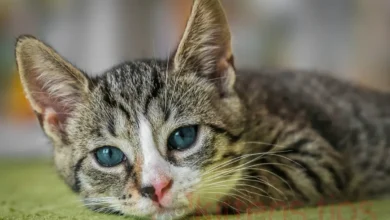
Ataxia in Cats. Causes, Symptoms, and Treatmen
How it manifests, what causes it, and what ataxia in cats is? A question that many cat owners ask when they notice balance issues in their feline companions.
Ataxia in cats (feline ataxia) is a neurological condition that affects a cat’s coordination and balance. Ataxia is characterized by difficulties in controlling voluntary movements of the body and limbs, causing the animal to have an unsteady gait and difficulties in moving normally.
Table of Contents
Main Types of Ataxia in Cats
There are three types of ataxia in cats, depending on the part of the nervous system that is affected.
Cerebellar Ataxia
The cerebellum is the part of the brain responsible for coordinating fine movements and balance. Cerebellar ataxia occurs when the cerebellum is affected by injuries, genetic diseases, or other conditions. Cats with cerebellar ataxia may exhibit uncertain and uncoordinated movements, such as unsteady walking and difficult jumps. They may have difficulty controlling their muscles for precise movements.
Vestibular Ataxia
The vestibular system in the inner ear controls balance and spatial orientation. Vestibular ataxia occurs when this system is affected by infections, inflammation, or tumors. Cats with vestibular ataxia may exhibit symptoms such as a tilted or rotating head, staggering gait, and loss of balance. These symptoms may be accompanied by nausea and vomiting.
Sensory Ataxia
This type of ataxia occurs when sensory nerves or sensory information transmission pathways are affected. Cats with sensory ataxia may have difficulty coordinating movements due to decreased sensitivity and sensory feedback. This type of ataxia can be caused by nerve disorders or diseases that affect the peripheral nervous system.
Symptoms of Ataxia in Cats
Cats with ataxia may exhibit signs similar to drunkenness, such as an unsteady and staggering gait and an increased tendency for drowsiness. Sometimes, the symptoms can be less pronounced, such as a slight head tilt or a mild curling of the toes during walking.
Among the distinctive signs of ataxia is nystagmus, an unusual eye movement that can occur as a result of issues in the central nervous system.
Cats experiencing sudden ataxia may have a tendency to roll or fall to one side and often experience significant nausea due to the sensation of instability. On the other hand, if ataxia in cats persists over time, they usually have the ability to adapt and are less likely to experience nausea.
Causes of Ataxia in Cats
Ataxia in cats can have a variety of causes, including the following:
Central nervous system or brain disorders. Brain tumors, injuries, inflammation, or infections in a cat’s brain or spinal cord can lead to ataxia by affecting the proper functioning of the central nervous system.
Cerebellar issues. Damage or malformations of the cerebellum can cause ataxia, as this part of the brain is crucial for coordinating movements.
Inner ear conditions. The vestibular system in the inner ear plays a crucial role in balance. Infections, inflammation, or injuries in this area can cause vestibular ataxia.
Genetic diseases. Certain genetic diseases can lead to ataxia, especially when they affect the functioning of the nervous system.
Toxicities. Ingesting toxic substances such as poisonous plants, household chemicals, or the wrong medications can trigger ataxia in cats.
Metabolic conditions. Some metabolic conditions, such as hypoglycemia or inherited metabolic disorders, can influence the normal functioning of the nervous system and lead to ataxia.
Infectious diseases. Infections with various microorganisms, such as viruses or bacteria, can affect the nervous system and contribute to the development of ataxia.
Autoimmune disorders. Ataxia in cats can also occur due to autoimmune disorders. These can cause the immune system to attack its own nerve cells, leading to neurological symptoms, including ataxia.
Trauma. Head injuries or spinal cord injuries can affect the functioning of the central nervous system or the cerebellum, leading to ataxia.
Degenerative diseases. Some degenerative diseases, such as intervertebral disc disease, can gradually damage nerve structures and cause symptoms of ataxia.
Depending on the three main types of ataxia in cats, the causes are as follows:
Cerebellar Ataxia
- Congenital malformations of the cerebellum.
- Cerebellar tumors.
- Head or spinal traumas affecting the cerebellum.
- Brain infections or inflammations affecting the cerebellum.
Vestibular Ataxia
- Inner ear infections or inflammations.
- Tumors in the inner ear or vestibular nerves area.
- Injuries to the inner ear or vestibular nerves.
Sensory Ataxia
- Peripheral nerve conditions responsible for sensory information transmission.
- Nerve injuries or compressions.
- Metabolic or genetic diseases affecting the functioning of sensory nerves.
Diagnosis – Ataxia in Cats
If you observe signs of ataxia in your cat, it is crucial to take it to the veterinarian immediately. The veterinarian will conduct a thorough review of the medical history and then perform a physical examination of the animal to evaluate any neurological abnormalities (affecting the nervous system).
Once the type of ataxia (sensory, vestibular, or cerebellar) is identified, additional tests may be necessary, such as blood tests, urine analysis, X-rays, and advanced imaging, to determine the underlying cause. These procedures will help establish a precise diagnosis and develop an appropriate treatment or management plan for your cat’s ataxia.
When ataxia occurs in cats, diagnosis often involves a gradual and meticulous approach, as symptoms can be similar in multiple conditions. Here are the common steps for diagnosing ataxia in cats:
Clinical examination. The veterinarian will perform a physical examination of the cat to observe obvious signs of ataxia, as well as other associated symptoms.
Medical history. The owner will be interviewed about the observed symptoms, their duration, and any risk factors or recent events that could contribute to the onset of ataxia.
Laboratory tests. Blood tests and other laboratory tests can help identify potential causes of ataxia, such as infections, metabolic disorders, or electrolyte imbalances.
Imaging. Imaging studies, such as computed tomography (CT) or magnetic resonance imaging (MRI), can be used to visualize the brain, spinal cord, and inner ears, identifying any lesions, tumors, or anomalies.
Functional tests. The veterinarian may perform tests to evaluate the cat’s coordination and the function of its nervous system, such as reflex response testing or balance tests.
Exclusion of other conditions. Because the symptoms of ataxia can be similar to those of other illnesses, the veterinarian will attempt to rule out other possible causes, such as toxicities or muscular disorders.
Consultation with a specialist. In complex or unclear cases, the veterinarian may recommend consulting a specialist in veterinary neurology for additional evaluations and advanced interpretations of symptoms and tests.
Treatment. Ataxia in Cats
The treatment of ataxia in cats varies depending on the underlying cause. For instance, if ataxia results from an infection, the veterinarian may prescribe specific antibiotics for treatment.
Idiopathic ataxia or ataxia without a known cause will be managed with supportive care, including the administration of anti-nausea medications. In this situation, the cat will require a safe and protected environment to prevent injury during the manifestation of symptoms. In some cases, assisted feeding and intravenous fluid administration may be necessary if the cat cannot eat or drink on its own.
Certain types of ataxia can be managed to maintain the quality of life, even if they cannot be completely cured. On the other hand, idiopathic ataxia may resolve on its own and may not recur in the future.
In the case of cats affected from birth, specific treatment may not be necessary, but their environment should be set up to prevent falls or injuries caused by a lack of coordination and balance.
The veterinarian will be able to make a more precise diagnosis and propose an appropriate treatment or management plan for the condition causing ataxia in your cat.
Related: Panleukopenia or Feline Parvovirus (FPV). Symptoms and Treatment
Conclusion
In conclusion, ataxia in cats presents as a complex neurological condition with various underlying causes, including congenital malformations, tumors, infections, injuries, and genetic factors, depending on the type of ataxia (cerebellar, vestibular, or sensory). Accurate diagnosis involves a systematic approach, combining clinical examination, medical history, laboratory tests, imaging studies, and sometimes specialist consultations.
Once the specific type of ataxia is identified, appropriate treatment is tailored to the underlying cause. Treatment strategies may range from addressing infections with antibiotics to providing supportive care for idiopathic cases. Managing the cat’s environment is crucial to prevent injuries during episodes of unsteadiness. Overall, early diagnosis and intervention are essential to improve the cat’s quality of life and ensure its well-being.


